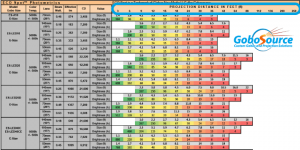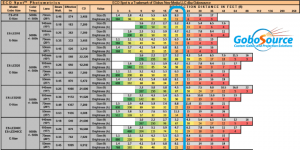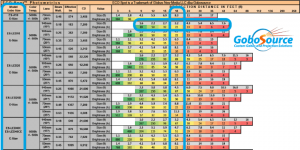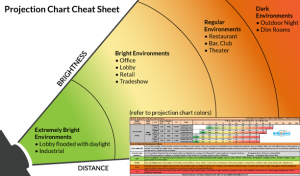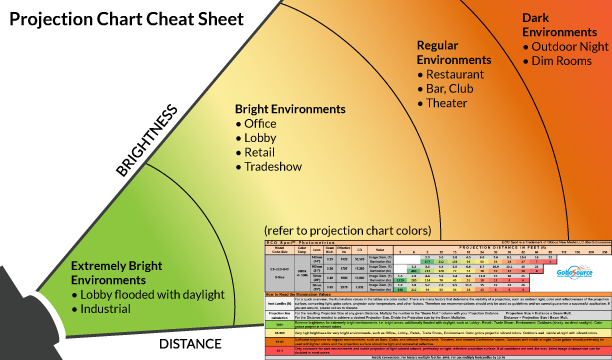
When purchasing a gobo image projector, one part of the process is figuring out what kind of projection lens you’ll need. A separate accessory from the gobo, the lens determines how far, wide and bright your image is projected. Think of it like the lens of a camera, while the gobo is the picture you’re trying to bring into focus, and the projector is the camera itself.
One of the most common questions we receive is how to read our projection chart, so we’re going to try and break it down for you here with step by step instructions, a real-life example, and a lovely new diagram. At the end of this blog post, you should be armed with the necessary tools to choose the right lens for your specific needs.
How to read our projection chart
(Click the pictures to zoom in)
Step 1: First, determine your projection distance in feet, aka the distance between your projector and the surface you plan to project the image onto.
Step 2: Follow your chosen projection distance down the column for the desired projection size. This is the diameter of the projected image and is typically between 3 and 8 feet for indoor projection and 6 to 40 feet for outdoor projection.
Step 3: Select a projector (aka your Model in the chart) that shows your desired image size with sufficient brightness. The brightness or illumination values are the colored rows (green to red) directly beneath the gray image size. Note that each color represents a different level of brightness based on the type of environment you plan to project in. See Diagram 1 below for examples of which levels of brightness are for which environments.
Diagram 1:
Before we go through a detailed example together using the chart, let’s look at three examples of projection variables and what type of lens you would need for each.
How to account for common projection variables
Long distance projection
For projecting a gobo over large distances you’ll need the right projector first, but you’ll also need to use a lens that projects a tight, narrow beam between 5 and 15 degrees. This is best for use at outdoor festivals or events where you want to shine a gobo image on a building or landscape in the distance.
Short distance, large image
Indoor uses, such as theater stage projection or at a club, require a completely different approach. You’ll have a broader range of projectors to choose from, but you’ll need to select a lens with a much wider beam angle, typically higher than 20 degrees.
Brightness
How bright you want your image to appear will also factor into the lens angle, not just the bulb and projector used. The further the distance, the larger the image and the darker the projection. The image size has a huge impact on the resulting brightness. For example, if you double the projection size by doubling the projection distance, you end up with only a quarter of the brightness. Likewise, if you need a brighter projection, move the projector closer or use a narrower lens.
Example: Small projection in 3 different lighting environments
Let’s look at three different lighting environments and figure out what lens you would need for each scenario to project an image that’s approximately 6 feet across from a projection distance of 18 feet.
The moody bar
For the first example, let’s say I need to project a logo onto the inside wall of a dimly lit cocktail bar. If we look at our projection chart, we can see an option for 18 feet under projection distance. If we follow that column down, we see quite a few options for projecting an image with a diameter of 6 feet. To narrow down our options, we need to think of our environment: a dimly lit bar. According to Diagram 1 above, we should be looking for orange under the brightness row which leads us to the below combo:
Best lens option: 70mm lens combined with the ES-LED10 projector for 11fc brightness. (Note that this lens has a beam angle of 15 degrees which is just within the optimal beam range for long-distance projection noted above).
The brightly lit restaurant
We now are in a much brighter environment, so let’s start with our projection distance (18 feet) and look down the row in search of a 6 foot diameter image size that’s yellow, according to Diagram 1. In the restaurant, you need to switch lenses and projectors for optimal brightness:
Best lens option: 100mm lens with the ES-LED-B40 projector for 43fc brightness.
The lobby with lots of natural light
When you have a space with large windows and lots of natural light, you’ll need to increase the brightness of your image for it to stand out. For this environment we’re looking for the color lime-green:
Best lens option: 140mm lens with the ES-LED-B90 projector for 202fc brightness.
As you can see, depending on the environment you will need different lenses, and in some cases different projectors, to achieve the desired effect for your gobo image.
Ready to order your lens? Refer to our full projection chart to determine which lens best fits your needs. Still have questions? Don’t hesitate to give our sales line a call: 1-831-431-8801 Sales. We’re happy to help!

